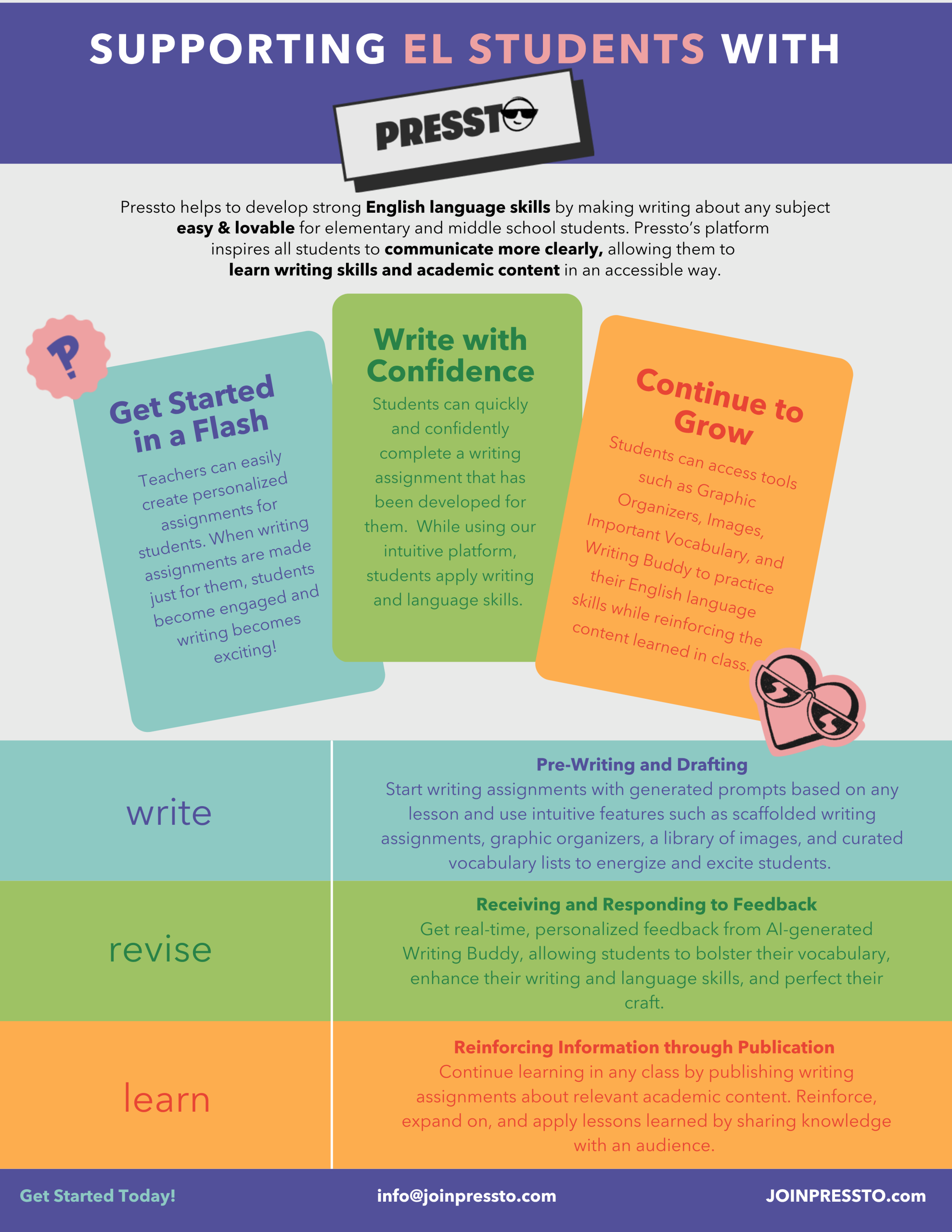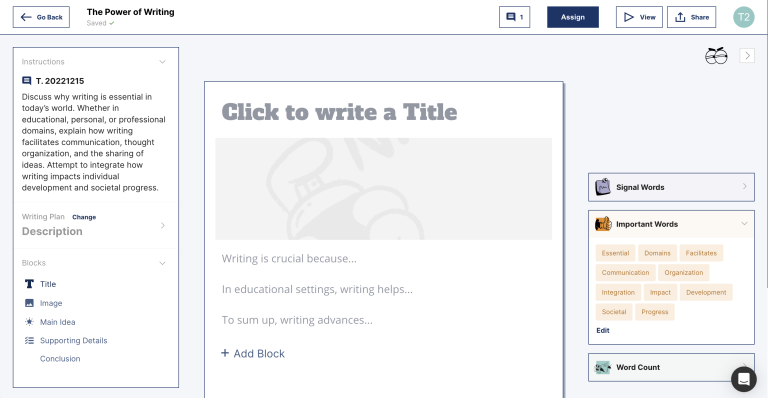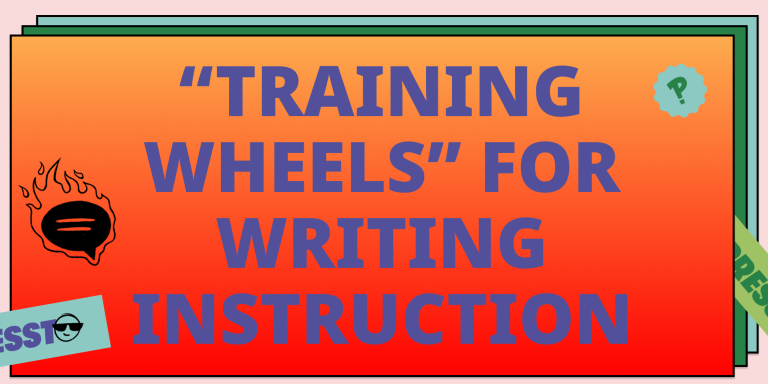Writing to Learn: Effective Writing Instruction Strategies for English Learners (K–12)
Writing is more than just a communication skill – it’s a powerful vehicle for language development and academic growth across all subject areas, especially for English Learners (ELs). Research consistently shows a strong correlation between writing practice and language acquisition. Because writing requires learners to actively generate language – choosing words, forming sentences, organizing ideas – it pushes them to process English deeply. In fact, engaging EL students in writing can even boost other literacy skills: one study found that when secondary students spent several weeks creating written projects (with text and graphics) and revising them, their reading comprehension scores improved significantly, even though reading wasn’t the primary focus.
Some of the highest-achieving high-poverty schools have identified a common factor to their success – a school-wide emphasis on developing writing skills across content areas. In short, effective writing instruction not only helps ELs become better writers, it builds their overall language proficiency and academic confidence.
However, writing in a new language can be intimidating for students. Educators often face groans or anxiety when it’s time to put pencil to paper (or fingers to keyboard). The good news is that a robust body of research, often referred to as the “science of writing,” points to strategies that can make writing a positive, productive experience for ELs. These strategies include structured, explicit instruction, purposeful scaffolding and differentiation, a focus on feedback and revision, use of multimodal supports, and opportunities for publishing to an authentic audience.
The Science of Writing: What It Means for ELs
The science of writing is based on decades of research into how students develop writing skills. It emphasizes that writing must be explicitly taught, with direct instruction in skills like sentence construction, text structure, planning, and revision. These findings are especially important for English Learners, who benefit from clear models and structured opportunities to practice.
Key findings from the science of writing include:
- Writing instruction improves not only writing quality but also reading comprehension and content learning (Graham & Perin, 2007).
- Students benefit from daily writing time, combined with targeted instruction on writing strategies (Graham et al., 2012).
- Revising and editing are critical components, best learned through cycles of feedback (US Department of Education, 2012).
- Teaching students how to plan, organize, and develop ideas leads to stronger writing outcomes (Shanahan, 2006).
For EL students, this research supports the need for intentional, scaffolded instruction that integrates language and writing development. Writing and thinking are deeply intertwined; when EL students write about content they are learning (for example, summarizing a science experiment or composing a history journal entry), it leads them to think critically about the subject matter and the language needed to convey it (Brisk & Zisselsberger, 2011).

Instructional Strategies Grounded in the Science of Writing
1. Structured and Explicit Instruction
ELs need more than just prompts to write; they need models, mentor texts, and explicit teaching. Show students how to construct a paragraph. Break down sentence types. Teach transition words. Use color-coding or sentence combining exercises. These structured approaches help students internalize both form and function. The gradual release of responsibility framework (Pearson & Gallagher, 1983) is especially effective: model the writing process, share the pen, then release students to try on their own.
Try This: Use mentor texts to highlight strong openings or transitions. Have students practice mimicking the structure before creating their own versions.
2. Scaffolding and Differentiation
Scaffolds help ELs do more than they could independently. These may include sentence frames, graphic organizers, modeled writing, and word banks. As students grow more confident, gradually remove supports. Scaffolding should be responsive to each student’s level of English proficiency (WIDA, 2012). Effective scaffolds support access to grade-level content without simplifying it (Gibbons, 2009).
Try This: Offer multiple versions of an assignment for different proficiency levels. For example, provide sentence starters for beginners and outline-only support for intermediate ELs.

3. Feedback and Revision Cycles
Feedback is central to improvement. According to the science of writing, students must learn to revise. For ELs, feedback should address both content and language use. Peer reviews, teacher conferences, and digital tools can support this. Graham et al. (2012) emphasize the importance of peer and teacher feedback loops in developing writing proficiency.
Try This: Create a simple revision checklist. Focus first on content clarity, then sentence variety, and finally grammar or word choice.
4. Publishing and Authentic Audience
Writing becomes more meaningful when there’s a real audience. Sharing writing in class, with families, or on a digital platform boosts motivation and pride. Authentic audiences increase effort and motivation among EL writers (Cummins & Early, 2011).
Try This: Let students create a class book, digital zine, or blog. Even printing and displaying writing on a classroom wall can validate student effort.
Integrating Science of Writing into Daily Practice
Here’s what this might look like in a classroom:
- Monday: Teach a writing mini-lesson (e.g. topic sentences)
- Tuesday: Use a mentor text and jointly write with the class
- Wednesday: Students write independently using scaffolds
- Thursday: Peer feedback and teacher conferencing
- Friday: Final drafts, sharing, and celebration
This routine provides structure while allowing room for growth and creativity. It reflects the science of writing by emphasizing modeling, practice, feedback, and authentic purpose.
Final Thoughts
The science of writing gives educators a clear path forward. When we combine structured instruction with meaningful writing opportunities, we help English Learners become confident, capable writers. Writing isn’t just a product of language learning—it’s a driving force behind it. Let’s teach writing not as a mystery, but as a craft. With the right tools, strategies, and encouragement, every EL student can discover the joy and power of writing.
References
- Brisk, M. E., & Zisselsberger, M. (2011). Scaffolding argumentation through genre-based writing instruction. Journal of English for Academic Purposes.
- Cummins, J., & Early, M. (2011). Identity Texts: The Collaborative Creation of Power in Multilingual Schools.
- Gibbons, P. (2009). English Learners, Academic Literacy, and Thinking: Learning in the Challenge Zone.
- Graham, S., & Perin, D. (2007). Writing Next: Effective Strategies to Improve Writing of Adolescents in Middle and High Schools. Alliance for Excellent Education.
- Graham, S., et al. (2012). Teaching Elementary School Students to Be Effective Writers: A Practice Guide. Institute of Education Sciences.
- Pearson, P. D., & Gallagher, M. C. (1983). The instruction of reading comprehension.
- Shanahan, T. (2006). The National Reading Panel Report: Practical Advice for Teachers.
- U.S. Department of Education. (2012). Teaching Elementary School Students to Be Effective Writers.
- WIDA (2012). Focus on Differentiation.







